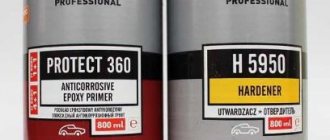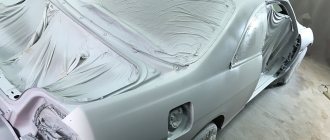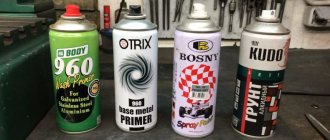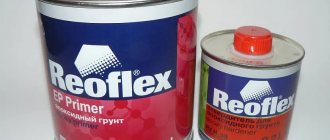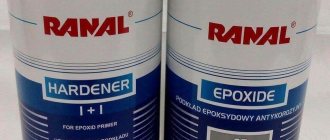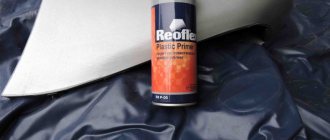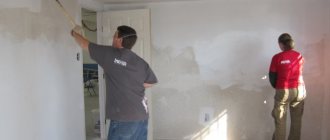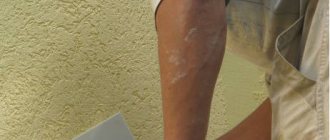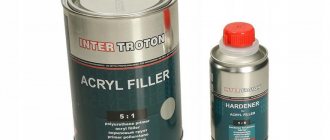Let's figure out whether to choose acidic or epoxy primer. In what cases, which one to use. And also how to use it correctly.
There is such an English word primer (prime: first, initial, primary). These two soils are primary. It is even more correct to call them primers, but the word “primer” is also applicable, since they perform the functions of a primer. Acrylic fill primer, for example, is called filler and is not a primary primer.
Expert opinion: acid or epoxy primer?
"Hi all!
Not long ago, I again came across the question of which is better, acid primer or epoxy primer. As I understand it, this question periodically worries people involved in repairs.. But, first, let’s clarify xy from xy))) So. » There are three main soils:
1) Acid 2K (etching, phosphating, reactive)
2) Epoxy 2K
2K is a two-component material
Acid 2K primer
We use it on bare, clean metal, or with corrosion residues (in the pores, for example)
Acid soil is primary and in its finished form is a complex chemical substance. As a result of complex chemical processes occurring in the soil after its application, we obtain a section of metal coated (depending on the composition of the soil) with lead or zinc.
Acid primer has excellent adhesion to many substrates (aluminum, zinc, fiberglass, steel, etc.), and most paints and primers also have adhesion to it (but only when it is completely dry). Hygroscopic (that is, absorbs moisture)
Epoxy 2K primer
It is also primary. Applied to bare, clean metal without traces of corrosion. It has good “physical” adhesion and chemical resistance, and can act as an insulator when repairing old paintwork. Non-hygroscopic (that is, does not absorb moisture)
Acrylic 2K primer
Acts as secondary, repair primers. It is also an insulator for some coatings. There are filling and leveling soils (there are also universal ones). Applied to polyester (polyester) materials and substrates, as well as to old paintwork. Hygroscopic (that is, absorbs moisture)
Do not putty on acidic soil! He needs to be isolated. How?
Primary acid primer is applied in a thin layer as it is non-filling and has a low working residue. You can dry and sand it, but then it will be of no use because it will be sawed off during sanding. Therefore, it must be covered wet-on-wet. And it must be covered with acrylic primer, since it does not interact (does not react) with acidic primer, unlike epoxy primer, which reacts with acidic primer, causing the properties of the acidic primer to change and it loses its qualities.
The same thing will happen if putty with a hardener gets on top of the acidic one. From such a proximity, the acidic soil is dissolved by this hardener and all the original properties of the acidic soil will be irretrievably lost!
Conclusion.
The acidic primer must be covered with a wet-on-wet acrylic primer, then let it all dry, then fill it with paint and then apply epoxy primer or putty.
Now, in simple terms, why do I prefer epoxy primer... The answer is terribly simple, YES BECAUSE EPOXY IS NOT HYGROSCOPIC, in other words, epoxy does not allow or absorb water. An example is the fact that on icebreakers, epoxy is used as primer. The second advantage of epoxy is its strength and resistance to chipping. Let's return to the acid soil, it has its advantages, but no matter how good it is, acid soil is hygroscopic and, accordingly, allows moisture to pass through.
It makes no sense to write about the significant difference in the principle of operation of an acidifier as a “zinc” based on the polarity of metals and an epoxy as a stopping primer with the highest adhesion and strength. This is information for technical manuals and other literature that induces sleep))))! I think that I have indicated the most basic reasons for preferring epoxy.
Self-etch primer
If the package says Self-etching, then this is a filling acid primer with the addition of zinc. The acid corrodes the metal, and the zinc immediately eats into it. The acid is usually phosphoric acid. Self-etching primer is designed to improve adhesion and smooth out uneven metal surfaces. This primer phosphates and primes the surface at the same time. First, a chemical reaction of the acid with the metal occurs, and then the polymer and anti-corrosion pigments form a protective film when dry.
Acid or epoxy primer? Which to choose?
Epoxy and acid primers
Recently, questions have often arisen regarding the use of various primers in body repair. Let's try to understand together what types of soils there are and in what case each of them should be used.
We will highlight three main types of primers: - 2K acrylic filler or leveler - 2K epoxy primer - 2K acid primer As special ones, we will consider 1K epoxy-based etching primers.
Acrylic 2K primer performs only a filler function and can sometimes be an insulator of one layer from another. As a rule, such soils are hygroscopic. (Hygroscopicity - vapor permeability). They do not absorb water like a sponge, but only accumulate evaporation and moisture, which then condenses upon cooling and accumulates in the form of microdrops on the surface of the metal under the ground. And this moisture evaporates for a very long time, because of this the corrosion process begins on the metal. Therefore, acrylic primers are used only for filling/leveling (pouring) putty or underlying layers of paintwork.
Epoxy primers are used primarily as an insulator. Such soil does not allow water, evaporation, or moisture to pass through. Also, epoxy primer 2K or 1K is the primary primer when working with metals such as aluminum, zinc, copper, etc., as well as with cataphoresis primers, as it has excellent adhesion and acts as a waterproofing agent. Epoxy primer is chemically stable, but is sensitive to UV radiation, so you should not store your car in the open sun after applying only epoxy primer to it.
The third group of primers is 2K acidic primers based on polyvinyl butyral. They are also called phosphating or reactive. These primers provide chemical adhesion and also contribute to the formation of a protective layer on the metal. Often we are not able to remove rust completely. It still remains in the pores and microcracks. It is in this case that acid soil is used. It converts the remaining corrosion, turning it into a phosphate film, which will further protect the metal from oxidation. Also, as a result of chemical reactions, lead or zinc is deposited on the repair surface, which is present in acidic soil in the form of chromates. These metals practically do not oxidize and, accordingly, reduce the likelihood of corrosion at the repair site.
When working with aluminum, galvanized surfaces, as well as with cataphoretic primers, in principle, we can use both epoxy and acid primers, whichever is closer to you.
Now let's look at the pressing issue of soil compatibility. Acrylic filler primer can be applied to both epoxy and acid primers.
Briefly about the main thing
An acid primer has a special purpose, which differs significantly from the tasks of acrylic and epoxy primers. It is used exclusively for primary processing, which significantly enhances the protection of metal from rust. Due to chemical protection, the paintwork is used for a long time without the formation of swelling, cracks and other defects.
Thanks to a layer of acid primer, metal surfaces, be it a car, a fence or a galvanized roof, will not be affected by rain, snow or other negative influences. For a long time they will have an attractive appearance and please the eye. The main thing is to understand the types of primer, choose the right one and apply it correctly to the surface.
Ratings 0
Industrial polyurethane paints
offers a wide range of industrial polyurethane paints at competitive prices. This type of paint can be used for painting concrete floors, for covering units and products made of metal and other materials.
Advantages of our industrial polyurethane paints:
-High wear resistance and durability
-Resistance to vibration and shock loads
-High chemical resistance (protection from solvents, all types of alcohols, short-term exposure to alkalis and acids)
-Color is preserved when exposed to ultraviolet light
-Protective properties are not lost over time
Primer Basics
After pasting the car, you can start diluting the soil. First of all, you need to mix it thoroughly to lift heavy components from the bottom of the jar, and then dilute it with a hardener (it is highly advisable to use only the original one) and a solvent (preferably the original one, but 646 is also possible). The proportions must be indicated on the can.
It is better not to dilute by eye, but to use a special container where you can see the grams.
It is advisable to filter the finished mixture through a proprietary filter or ordinary gauze, folded 3-4 times. Usually it is enough to apply the primer in 2-3 layers
It is extremely important to maintain a drying time of 5-10 minutes between coats.
Otherwise, the soil may boil, which is highly undesirable.
There are also primers in black, white, red and other colors. Using this palette you can mix primers and get the desired color
It is important to remember that the materials being mixed must be from the same company.
Before applying the primer, you must wipe the car with an antistatic cloth, then degrease it with anti-silicone or alcohol.
According to technology, the first layer needs to be filled normally. But, if the primer is applied to the old paintwork, which in some places has been rubbed down to the old primer, then it is in these places that the new primer can be undermined. To prevent this, you need to spray the first layer and dry it for about 10 minutes.
The second and third layers can be poured, then allowed to dry for 24 hours.
The soil can be treated either dry or with water. It should be remembered here that soils partially absorb water, which over time leads to metal corrosion, therefore, it is better to process dry. A special grinding machine can help with this.
For metallic paint, the body should be sanded with R-600 and R-800 sandpaper, but for regular acrylic, R-400 and R-500 will be sufficient.
New parts need to be given extra attention, because they are covered with shipping primer (usually black). In order for the car repair to be of high quality, the transport soil must be sanded down to metal using R-240 sandpaper.
After this procedure, you can put 2-3 layers of soil.
After 10-15 minutes, you need to develop the primer with paint of a contrasting color. The next day you can start cleaning. During processing, development may show minor unevenness. When is it okay not to remove old paint from walls?
In this case, you will need to re-prime the flaws or the entire part.
Do-it-yourself car priming is absolutely safe if you approach it correctly. The fact is that during any paintwork, including body priming, it is necessary to use personal protective equipment (respirator, gloves, suit). Primer fumes are very harmful, so be careful about your health.
Industrial paints for metal
Polyurethane paint for metal has a high degree of resistance to climatic influences, as well as direct contact with aggressive chemical environments. Forms a coating that well protects the metal from exposure to water and prevents the spread of rust. In addition, after treatment with paint, the metal surface becomes more resistant to mechanical stress and scratches.
Features of polyurethane paints for metal:
- Our metal paints are non-toxic
- Retains color throughout the entire period of use
- Elasticity allowing painting of thin sheet flexible metal
- Economical consumption
Advantages
According to experts, the main positive quality of epoxy-based soil (regardless of its shape) is the ability to withstand significant temperature fluctuations, atmospheric and mechanical loads.
The second important property is the minimum drying time, which makes using the composition as convenient as possible. This trifecta of advantages is completed by adhesion; the applied composition firmly adheres to the metal.
The treated body retains all visual features and technological characteristics for a long time.
Practice shows that the epoxy composition is suitable even for metal surfaces that are in constant contact with water, so it can provide the highest level of corrosion resistance to a car that is in contact with moisture only periodically.
Classification Features
The number of compositions presented on the modern market amounts to dozens; they can be classified according to a variety of technological and operational indicators, be it the degree of adhesion or the effect on the metal. However, this division is not the most significant.
The most important factor is the composition, which allows the products to be divided into two large groups:
- One-component . The composition does not contain a hardener, which increases the drying time. This is inconvenient when treating a vehicle, so solutions are not widely used;
- Two-component (multi-component). A hardener must be added to the composition, due to which the drying time is significantly reduced.
Primers in aerosol form
This group of products should be considered separately. The price of primer in a can is higher compared to its analogues in ordinary metal containers, however, it has an undeniable advantage - ease of use.
There is no need for dilution or additional purchase of solvents, pigments and other additives. The aerosol is immediately ready for use; you just need to shake the can vigorously before spraying, or perform other simple steps indicated by the manufacturer.
If it is planned to process the entire vehicle body, the use of an aerosol is not economically feasible; the financial investment will be too significant.
Another thing is the repair of individual sections of the body, be it metal sills or fenders. In such a situation, a spray can is the optimal solution, thanks to which you will be able to save a lot of time and money, carry out restoration on your own, without purchasing auxiliary materials or contacting specialists.
Useful video on why epoxy primer is in cylinders:
Famous brands
As already noted, there are many primers available in stores. Without experience, it is extremely difficult to find a solution that will be truly durable and reliable, capable of protecting the car body from external negative factors.
However, based on reviews from drivers and service center specialists, some conclusions can be drawn.
Novol soil (Protect 360), produced by the Polish brand of the same name, has a good reputation. Yes, this product is more expensive than many of its analogues, but the high cost is fully compensated by the quality.
Practice shows that the composition is suitable for treating metal surfaces, even those in poor condition, covered with significant areas of intense corrosion.
For example, it is soil from Poland that is used by many commercial enterprises specializing in passenger or cargo transportation.
The solution promotes maximum protection of metal from rust and temperature fluctuations, extending the life of vehicles. Increases the overall profitability of the enterprise by reducing costs associated with repairs and machine downtime.
Industrial polyurethane paints for concrete
We offer to buy paint for concrete coatings in Orenburg - a reliable means of protecting floors, walls, ceilings, and any concrete structures. Such coatings are intended for use indoors or outdoors under a canopy.
Where is concrete paint used:
- warehouses and hangars
- refrigeration and freezing rooms
- garages, car washes, car services, parking lots, retail spaces
- exhibition areas
- residential and public spaces
- agricultural facilities
- treatment plants and settling tanks
- other objects
Industrial coatings for concrete have increased wear resistance due to the presence of polyurethane in their composition. It is this that provides high resistance to aggressive manifestations and chipping.
Advantages of our concrete paints:
- Deep penetration into concrete
- Perfect sealing and dust protection
- Wear resistance and strength
- Operation at temperatures ranging from -60 °C to +120 °C
- Non-toxic and odorless
When choosing industrial paint for any surface, contact us; with us you get not only the best coating at an excellent price, but also a reliable partner.
Scope of use
Painting with epoxy primer is in demand not only when working on a vehicle - this type of substance can be used to coat other large objects, but only metal ones.
Important! The primer for concrete work should not be confused with the one used for metal work. These are completely different products in composition, and the result of the work can be unpredictable, not in the positive sense of the word.
In general, “epoxy” can be used in the following cases:
- on top of “bare” metal - it can be either steel or aluminum;
- over a mixed surface - with putty;
- as a final insulating layer;
- as a means of improving surface resistance to mechanical damage;
- application to fiberglass parts, but only as the first layer.
Characteristics and properties of acidic primer for cars
The main component of acid primer for cars is phosphoric acid, which, when applied to metal surfaces, forms a strong, reliable film on them that does not allow moisture and air to pass through. The main characteristics of acid primer are high adhesion and unique anti-corrosion properties.
In addition to phosphoric acid, the primer contains manganese and zinc compounds, which act as protectors. When they interact chemically with metal, they block the appearance of corrosion, and in case of local damage to the car body, they block the further spread of rust. The principle of operation of the acid primer composition is based on the mechanism of metal passivation.
The scope of application of acid primer is wide; it can be applied to various types of metal surfaces. Acid primer belongs to the category of primary reactive primers; after its application to metal car body parts, the use of a secondary primer paste is required.
Unlike acrylic or epoxy primer for cars, a final paint coating cannot be applied to an acid primer.
The main characteristics and properties of acid reactive paste include:
- Wear resistance.
- Resistance to moisture, the appearance and spread of metal corrosion.
- Hygroscopicity.
- High adhesion.
- Heat resistance.
- Resistance to precipitation (rain, snow) and other negative external factors.
- Resistance to aggressive chemicals (including salt).
What is special about the composition?
To combat rust, acid primer is a powerful tool because it can completely destroy it. If you want to comply with car treatment technology, it is better to give preference to expensive acid primer.
It is better to apply the composition to welded seams with a brush, but it is better to treat a large area of metal coating by spraying.
Acid primer is a mixture of phosphoric acid and zinc, it is primary and is sprayed directly onto the bare metal. Before applying it, the metal surface must be degreased to remove any remaining corrosion. Acid soil dries within fifteen minutes at a temperature of 20 degrees.
After drying, it is necessary to treat the surface with leveling acrylic primer. You should not apply this composition to old putty, only to clean metal. If there are old coatings, use epoxy primer.
In all cases of using acidic primer, it must be covered with a two-component filler primer. Only after this is it possible to apply additional putty, secondary primer and painting. Nothing other than an insulating primer should be applied to the acid coating. An etching primer is one of the means of treating a car to protect the metal body from corrosion. This composition is also used to protect welding seams from corrosion.
Acid etch primer has the following distinctive qualities:
- resistant to salts and moisture;
- is wear resistant;
- protects against any negative external influence.
In the video: what is the difference between epoxy primer and acid primer.
Types and features of using acid primer for cars
Acid primer for car body protection, depending on its composition, is divided into two types:
- One-component – before application to metal surfaces of the car body, it does not require additional preparation (dilution with an activator and other compounds/solvents/catalysts).
- Two-component - before use, the acid primer requires the addition of a hardener (phosphoric acid). When interacting with components of the composition (artificial resins and pigment additives), the acid generates heat.
Using an acid prime paste before painting a car allows you to create a strong base for painting.
The primer is applied exclusively before painting the body elements. Various tools, devices and techniques can be used to apply the composition:
- Standard universal brush.
- Spray gun.
- Dipping the car body into a bath with the composition.
- Electrospray.
- Electrodeposition.
The choice of application of the primer paste depends on the conditions of use. At automobile manufacturing plants, they use the method of dipping the body into a bath of reactive soil, which improves the efficiency and quality of processing, as well as significantly reduces its duration.
In a garage, acid primer is applied using a regular brush or mechanical/electric spray gun. The first option is suitable for local application of primer paste, and the second method allows you to achieve a more uniform and accurate coating.
The reactive wash primer is applied only to carefully prepared metal surfaces of the body - after they have been cleaned of dust, dirt and oil traces. Unlike other types of automotive primers, the layer of phosphating paste must have a minimum thickness, which is due to the good adhesive properties of the composition.
To increase the effectiveness of corrosion protection, acid primer is applied to all body elements evenly; for these purposes it is advisable to use the spraying method. The primer fits well on any metal surfaces of the car, as well as on welds.
A two-component primer requires a step-by-step application, with a minimum time interval of 5 minutes between spraying the subsequent layer. It takes at least 30-90 minutes for the primer paste to dry completely (a more precise drying time is indicated in the instructions for the composition). The recommended drying temperature is not lower than +15 degrees.
Application methods
Acid primer can be applied using different methods:
- With a regular brush;
- Spray gun;
- Lowering the part into a container with primer;
- Spraying using electric current;
- Electrodeposition technology.
In garage conditions, the first two methods are used, and immersion is used in most cases in production. Spraying provides better and more uniform coverage, unlike brushing.
The metal surface is treated with an acid primer after thorough cleaning and degreasing. Two-component primer must be applied in stages (1 – 3 layers). The minimum time between applications is five minutes. The primer dries in 30 – 90 minutes, more precisely the time is indicated on the label of this product.
If necessary, put putty on top of the primer. It is permissible to do the opposite - first the filler, and then the primer. It is not allowed to combine polyester putty and etching primer.
How to choose a primer paste?
Acidic soil acts as a reliable protection for the car body from numerous external factors, including salt, moisture and corrosion. Minor scratches, mechanical damage and chips can lead to rust, so you should not skimp when purchasing primer paste. The market of modern materials for car repair and painting includes acid primers from various manufacturers - Novol, Body 960, Getapro, Khimrezerv, Mixon and others.
Address: LLC TD "Tinting Center", 454038, Russia, Chelyabinsk, Vinnitskaya st., 17
Phone fax: +7 +77
Stamps
The choice of the optimal acid primer directly depends on the characteristics of the surface being treated. The most popular are:
- DUR 1:1 . Reactive primer with phosphate. High-strength reliable coating with good adhesive ability. The big advantage is that it does not contain chromates. A special reaction catalyst is included with the primer to speed up curing.
- Body 960 Wash primer . Can be used on any surface. Contains 2 components. When used, mix with hardener. After coating the surface, no sanding is required, only a leveling layer, with the exception of polyester. Has a yellow color.
Body 960 Wash primer Source ad-cd.net
- Mobinel . One-component. Characterized by good anti-corrosion properties. Used for aluminum, galvanized, stainless steel. Available in grey.
- Radex CR 1+1 . The primer perfectly etches the metal, reliably protecting it from corrosion. The composition contains liquid and hardener. It has excellent anti-corrosion properties and good adhesion.
- Reoflex 2K 1+1 . Two-component yellow primer. Contains a phosphoritating ingredient and a hardener. Excellent for restoring damaged coatings.
It is better to choose the appropriate option with the help of a specialist.
Primer for painting a car, overview of primer types and manufacturers.
Good afternoon everyone. The topic of today's article is primer for painting a car. And as you may have guessed from the title, the article will be a review, we will look at the types of automotive primers and arrange a short review of manufacturers widely represented on the Russian market.
Let's agree on the shore - in this review we are not considering primers sold in aerosol cans.
General rules for applying automotive primers.
— The primer is applied to the prepared surface, i.e. degreased and matted with sandpaper number 120-180
— The primer is applied from a spray gun with a 1.4-1.6 mm nozzle
— Matting of the primer is carried out only after it has completely dried (24 hours at 20 degrees for 2-component acrylic primer)
— When applying a coating to the ground using the wet-on-wet method, materials from the same manufacturer should be used.
— The primer is not intended for filling body irregularities; there is liquid putty for that!
- the soil should be diluted strictly in the proportion recommended by the manufacturer! If you pour a lot or a little hardener, there is a high probability that the soil will either take a very long time to dry or remain soft.
Dilute the mixture
Acrylic primers are component compositions. The technology of their dilution depends on this. For such purposes, experts recommend using several substances:
- The optimal thinner will be a special acrylic mixture that is compatible with a particular brand. Often, such solutions are recommended by the manufacturers of these products.
- Water. This mixture can only be used in cases where the soil contains a similar component. Water-acrylic mixtures are often diluted.
Some users recommend using a special thinner 647. But this issue is controversial, since the use of this product depends on the properties of the selected primer.
The amount of thinner often does not exceed 25% of the total volume of the mixture. Please note that it is important here to also consider the amount of hardener that is added to the solution when mixing.
You can find out the exact proportions and recommended solvent on the packaging. It is important to follow all basic recommendations to obtain high-quality and durable protection.
What primer is used to prepare for painting cars?
Acid soil (reactive soil).
This is the so-called primary primer; it contains orthophosphoric acid (a rust converter). This type of primer is applied as the first layer to bare metal or old paint.
This is what the car looks like after applying acid primer:
It is not allowed to apply primer to materials with a polyester base (putties and their resins).
The primer provides excellent adhesion and anti-corrosion protection, but it must be over-primed with a two-component acrylic primer.
Painting directly onto acidic soil is unacceptable!
Epoxy primer.
As you guessed from the name, this type of primer is based on epoxy resin and perfectly isolates body metal from atmospheric air. Epoxy primer is applied to bare metal, old paint and putty (unlike acid primer).
This type of primer must also be covered with acrylic primer, although I painted metallic paint on it and there were no reactions.
Attention - this type of soil cannot be dried with infrared dryers; heating will soften it, flow and lose its properties.
Acrylic two-component primer.
The most universal primer used in body repair. For reasons of economy, acid and epoxy primers are extremely rarely applied to the body. We only do this on expensive cars! Usually the car is tinned, matted, puttied, matted again and primed with acrylic two-component primer.
This primer can be painted wet, matts quickly and easily, and has excellent hiding power.
Life hack - This primer can be tinted! If you tint the primer to the base color, paint consumption is reduced, and, most importantly, when chips and scratches reach the primer, they do not stand out on the car like this:
Primer for plastic.
Usually this is a one-component primer; it is an adhesion enhancer. Personally, we don’t use it for car repairs. We are used to matting the plastic bumpers with sandpaper with a score of 240-360, applying acrylic two-component primer, drying it, matting it again and painting it.
This is how to apply primer to a car body:
Review of primer manufacturers.
Worst primer or cheap and runny.
It so happens that the author of this article has been painting cars for many years, and if in the late 2000s Vika paint and primer from Yaroslavl ruled in terms of price/quality ratio, now this one is worth taking their primer only if you need to quickly paint a couple of parts and sell the car ….
The fact is that by buying a can of NOVOL, you will prime the average sedan. NOVOL soil is so thick that it will dilute 3-4 times! In the case of Vika, the can cannot be diluted even twice, since it is already very liquid. The result is that the price seems low, 400 rubles. at the time of writing, but in fact, due to the concentration, the primer will be more expensive than average manufacturers. And the quality leaves much to be desired... The simplest thing is that if you stick the electrode vertically into an open novol jar, it will remain standing; in the case of vetch, they can interfere with the soil without straining.....
A reasonable compromise is NOVOL.
Basically, in Russia novol is known as a Polish manufacturer of car putties, but in fact the list of their products is quite wide, and primer for cars occupies a fairly significant part of this list.
The soil itself is thick, has good hiding power, is easy to sand and, thanks to its thickness, shows one of the largest yields of product per jar...
What else do you need to know?
Many service stations practice applying acid primer to the surface of the car body intended for painting. This treatment procedure is called “louse primer”. As a result of acid priming, the composition retains its properties for two days after mixing the two components. The application of two-component automotive primer is carried out in stages. The metal dries within two hours.
It is recommended to sand the reactive primer with grain sandpaper.
Considering the vulnerability of the car surface, the choice of primer for corrosion protection must be approached responsibly. If this material is of poor quality, then the paint begins to sag and the surface of the car loses its attractiveness. Automotive primer has good adhesion to the body.
Primers are divided into:
The most popular of them (for metal protection) has two components. Acid soil must be covered with a two-component filler primer. Such compositions are highly wear-resistant and are perfectly applied to metal surfaces. Thanks to the treatment of cars, it is possible to stop the spread of rust on their body. A special feature of acid primer is the ability to be sanded. If there are defects on the surface of the car body, grinding is not carried out.
